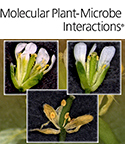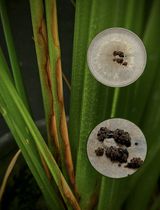- EN - English
- CN - 中文
Wheat Root-dip Inoculation with Fusarium graminearum and Assessment of Root Rot Disease Severity
浸根接种法评估禾谷镰孢菌导致小麦根腐病的致病力
发布: 2017年03月20日第7卷第6期 DOI: 10.21769/BioProtoc.2189 浏览次数: 12012
评审: Zhaohui LiuSwetha ReddyAnonymous reviewer(s)
Abstract
Fusarium graminearum is one of the most common and potent fungal pathogens of wheat (Triticum aestivum) and other cereals, known for causing devastating yield losses and mycotoxin contaminations of food and feed. The pathogen is mainly considered as a paradigm for the floral disease Fusarium head blight, while its ability to colonize wheat plants via root infection has been examined recently. F. graminearum has a unique infection strategy which comprises complex, specialized structures and processes. Root colonisation negatively affects plant development and leads to systemic plant invasion by tissue-adapted fungal strategies. The pathosystem wheat root - F. graminearum makes available an array of research areas, such as (i) the relatively unknown root interactions with a necrotrophic pathogen; (ii) genes and pathways contributing to (overall) Fusarium resistance; (iii) induced systemic (whole-plant) resistance; (iv) pathogenic strategies in a variety of host tissues; and (v) age-related changes in the single-genotype responses to seedling and adult plant (root/spike) infection. The presented Fusarium root rot bioassay allows for efficient infection of wheat roots, evaluation of disease severity and progress as well as statistical analysis of disease dynamics.
Keywords: Fusarium root rot (镰孢菌根腐病)Background
The Fusarium root rot (FRR) bioassay uses root-dipping for inoculation in combination with different measurements of disease severity parameter. This protocol is principally also applicable to investigations of other root-fungus interactions. The presented root-dip inoculation proved to be an effective and reliable method to investigate wheat root-Fusariuminteractions (phenotypically and histologically) and to screen wheat genotypes for their response to root infection (Wang et al., 2015). Using the described protocol, genetic, molecular, and metabolomic aspects of the FRR disease have meanwhile been examined with reliable results in terms of biological repetitions and consistent observations across different research approaches. This corresponds with observations made in a study on the Verticillium wilt disease, which characterised root-dipping as superior to the pot immersion or soil infestation method in terms of effectiveness and reliability (Trapero et al., 2013). Growing wheat seedlings in F. graminearum contaminated (root zone) soil led to FRR-genotype responses similar to root dip inoculation (Wang et al., 2015), but the infection conditions are comparatively less controlled in terms of root specificity and time of infection. This might be a restriction for investigations that require time-based analyses. The use of Petri dishes to germinate and inoculate roots via mycelial agar plugs is a method that has been applied to F. culmorum infection in wheat seedlings (Beccari et al., 2011). However, in comparison to root dip inoculation, this method is not applicable to adult plant root infection, as was done in our lab to study plant age-related effects on FRR disease progress and wheat responses.
In the described protocol, disease severity can be assessed by percentage reductions of diseased root biomass, root and shoot length as well as by rates of visible root necrosis. FRR significantly inhibits root biomass production of wheat seedlings and adult plants (Wang et al., 2015), which can be measured by quantitative real-time PCR (qPCR). Disease severity and progress in terms of fungal growth can be monitored by measuring the relative amount of F. graminearum DNA in the host tissue by qPCR. This also enables detection and monitoring of infection during or in case of symptom-free disease periods. The F. graminearum spread into the lower stem internode is a crucial event as it initiates the colonisation of upper stem internodes, leaves, further tillers and even spikes (Wang et al., 2015) and can be readily evaluated by appearance time and rate of visual necrosis. For the FRR disease progress over time, a good agreement was found between the quantified relative F. graminearum biomass in roots and the measured impacts on seedling growth or the rated visible symptoms (Wang et al., 2015). Briefly, seedlings with the lowest level of F. graminearum accumulation measured displayed relative minor root necrosis and reductions in root biomass and length, while relatively moderate and maximum levels of pathogen accumulation each led to correspondingly moderated and maximum disease impacts and symptoms. Finally, Fusarium resistance is quantitative or partial. Therefore, the combination of classical, subjective tools such as symptom rating with the sensitive, non-subjective qPCR diagnosis of pathogen and/or root biomass proved to be advantageous, in terms of an improved assessment of disease dynamics and genotype performances.
Materials and Reagents
- Parafilm
- Cheese cloth
- Fine sand (washed and sieved), obtained from construction or agricultural market, autoclaved at 120 °C for 30 min
- Aluminium foil
- Polystyrene disk (thickness 10 mm)
- F. graminearum isolate ‘IFA 65’ (University of Natural Resources and Applied Life Sciences, Department for Agrobiotechnology, Vienna, Austria)
- Synthetic nutrient agar medium ‘Spezieller Nährstoffarmer Agar (SNA)’ (Leslie and Summerell, 2006)
- Tween-20 (Carl Roth, catalog number: 9127 )
- MENNO Florades (MENNO CHEMIE Norderstedt)
- Sodium hypochlorite solution (Carl Roth, catalog number: 9062 )
- Wuxal Super (Manna, Düsseldorf)
- Liquid nitrogen
- Potato dextrose broth (PDB) (Sigma-Aldrich, catalog number: P6685 )
- FastStart Universal SYBR Green Master (Roche Molecular Systems, catalog number: 04913850001 or 04913914001 )
- Potassium dihydrogen phosphate (KH2PO4)
- Potassium nitrate (KNO3)
- Magnesium chloride heptahydrate (MgSO4·7H2O)
- Potassium chloride (KCl)
- Glucose
- Sucrose
- Agar
- Synthetic nutrient deficient agar (SNA) (see Recipes)
Equipment
- Climate chamber with 20 °C under cool-white and near-UV light illumination for preparation of fungal culture
- Haemocytometer
- Light microscope (Zeiss)
- Magnetic stirrer
- Climate chamber with a 16 h photoperiod of 22 °C/18 °C day/night and 60% humidity for plant cultivation
- Flat tray
- Rotary shaker
- Pot (7.5 x 7.5 x 8.0 cm)
- NanoDrop ND 1000 (Thermo Fisher Scientific, model: NanoDrop ND 1000 )
- ABI Step One Plus real-time PCR system (Applied Biosystems)
Software
- PSS 20 (IBM SPSS Statistics 20; IBM Corp., USA)
Procedure
文章信息
版权信息
© 2017 The Authors; exclusive licensee Bio-protocol LLC.
如何引用
Wang, Q. and Gottwald, S. (2017). Wheat Root-dip Inoculation with Fusarium graminearum and Assessment of Root Rot Disease Severity. Bio-protocol 7(6): e2189. DOI: 10.21769/BioProtoc.2189.
分类
微生物学 > 微生物-宿主相互作用 > 真菌
植物科学 > 植物免疫 > 病害生物测定
您对这篇实验方法有问题吗?
在此处发布您的问题,我们将邀请本文作者来回答。同时,我们会将您的问题发布到Bio-protocol Exchange,以便寻求社区成员的帮助。
Share
Bluesky
X
Copy link














